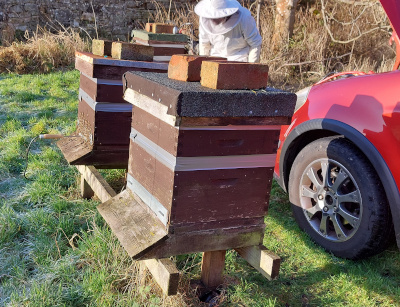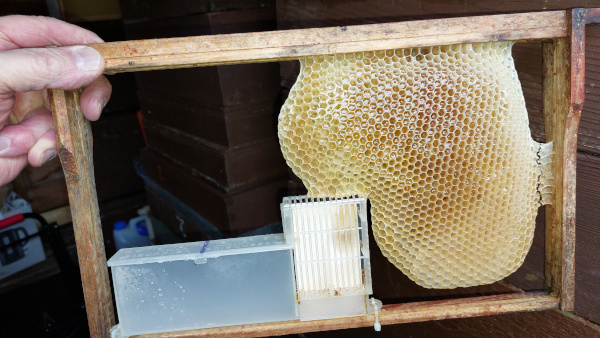Honeybee Health, Pests & Diseases
Honeybees, just like any other live stock are susceptible to various diseases, ailments, and pests. Some of these are very persistent, have a high levels of contagion, and have disastrous effects necessitating the destruction of hive and colony and are ‘notifiable’ under the The Bee Diseases and Pests Control (Scotland) Amendment Order 2011 and the The Bee Diseases and Pests Control (Scotland) Amendment Order 2021. It is the responsibility of the beekeeper to know and recognise all honeybee diseases and pests, how to treat them, and how to manage apiary biosecurity. A daunting task you might think but there is plenty of support around to keep on top of this, especially ‘BeeBase’ the Animal and Plant Health Agency's (APHA) National Bee Unit. If you keep honeybees in the UK it is recommended that you register with Beebase to ensure you keep up to date with the latest info and advice. Use the disease page menu to visit / download the honeybee disease pages for info on the diseases and pests, how to recognise them, how they spread, and what to do about them. Only use 'approved' products for treating your colonies, download the CSL FAQS document for a list of currently approved products.
Diseases present in your bees can easily transmit to other bees and apiaries nearby!
If you suspect a disease occurrence in your apiary or you are in doubt, seek help without delay from a mentor, your local beekeeping association or community, or contact your local Bee Inspector, they will all be pleased to help. It's always good practice to make your local beekeeping community aware of any disease or pest issues you are experiencing.
Apiary Biosecurity
The risks of pests and diseases is ever present in and around the countryside, and unchecked they have the potential to spread quickly, impact badly on honeybee health, cause economic hardship, and lead to colony losses and movement restrictions. As a beekeeper you are responsible for managing the health of your bees, and for limiting the introduction and spread of pests and diseases. Managing the biological security of your apiary whether you have one or two hives, or ten or twenty, requires some simple planning.
The UK Government encourages everyone to take responsibility for biosecurity, and regard this as vital in maximizing honeybee health and population sustainability, and maintain productivity. To minimise the risk of contamination and spread of pests and disease there are some basic practices to consider: Apiary Hygiene; Colony Health.
Include a plan for managing your Apiary Bioseurity when you are carrying out your Apiary Health and Safety Risk Assessment. You can view an Example Risk Assessment here.
Apiary Hygiene
All hive components, tools, and products are potential vectors for disease, as are the bees themselves. Much can be done to minimise the risks of contamination and spread within the apiary by observing good hygiene practices. Avoid unnecessary vehicle and personnel access to apiary. Always thoroughly clean clothing after visits to other apiaries. Keep protective clothing clean and free of old honey, wax and propolis. Consider using disposable gloves. Clean tools and equipment regularly using suitable mix of water and washing soda. Sterilise hive components by scorching or with suitable sterilising medium. Collect scrapings and brace comb and remove from apiary to discourage robbing. Store boxes and wax comb in a cold dry environment to discourage the ever present wax moth.
Keep hives in good repair, replace broken or damaged parts to ensure good fit and discourage robbing. Keep brood comb under 3 years old by systematic replacement. Remove all unused hive components and frames from the apiary. To avoid crushing bees when manipulating hives, place components back diagonally then square up. Keep screens in clean condition if used.
Colony Health
Diseases will most likely be brought in to the apiary by the bees themselves. Flying up to and over two miles to forage for nectar and pollen will bring them into direct contact with other bees seeking to exploit the same sources, they will even visit other apiaries and hives to rob them of their stores, so the opportunity for disease transmission is ever present. The degree of infection can vary and colonies that are already weakened by other circumstances may suffer to a greater extent and especially in early spring. The more care you take for the health of each and every colony, lowers the chance of catching disease, and lowers the chance of passing it on.
Keep hives and internal components clean and in good repair. Discard old components and rotten frames off-site. Keep brood frame foundation under 3 years old by systematically replacing them, only use clean foundation from a known source. Use careful handling practices when carrying out inspections, avoid crushing bees (other bees will clean up carcasses and spread any exposed infections), use clean screens or dummy boards to avoid robbing during inspections. Avoid moving frames between hives.
Spray poisoning is not a frequent problem, but when large numbers of dead bees are discovered at the hive, with distressed and odd behaving bees on the ground, it may be that there has been a spray incident. Spray liaison schemes exist but they don't always work in practice, it helps to be on good terms with the local farmers and know when they are going to spray. Simply shutting the bees in the night before and keeping them confined for a day averts disaster. To confirm a spray incident, collect dead bees and send them to SASA in a paper bag.
Varroa - The Persistent Pest
By far the most persistent pest of our honeybees currently is the Varroa mite (Varroa destructor). It arrived on our shores in 1992 and is now endemic across all of mainland UK. The parasitic mites live of the life blood of the bees and utilise the brood nest and larvae to breed. Not only do they severely effect the growth and performance of adult bees, they also carry and transmit other infections and viruses to and through your colony. They will also transfer from bee to bee while in their phoretic stage and consequently from colony to colony. Left untreated for this pest a colony will eventually succumb and completely collapse. Managing for varroa involves planning year round treatments to reduce their populations down to a level that does not harm your colonies by using different treatments at different times of the year. Unfortunately there is no quick fix or permanent solution. Use the Varroasis page for info on the disease and how to manage it. There is also helpful information on BeeBase for managing this and other diseases.

Sublimating a colony with oxalic acid using an electrically heated wand applicator on a bright frosty 0℃ January day. Jump leads from the car battery providing a convenient power source. Correct application ensures a good start to the season.
More on Oxalic Acid. Download the Sublimating Hives info sheet for more information on this highly effective method used to aid the control of varroa mite numbers in honeybee colonies.

Nassenheider Evoporator removed after September fumigation with formic acid. The honey crop was removed before treatment. Note the bees have built comb and part filled it with heather honey!
Used in Late July, August, and September as part of your IPM, fumigation with formic acid can be an effective treatment. More on Formic Acid Treatments
Careful Inspections
Regular observations and inspections are key to monitoring the health of your colonies. Know the signs of healthy brood and bee behaviour across the seasons, be on the lookout for anything unusual. Carry out systematic inspections of every colony, checking colony activity, hive component condition and security, amount of bees in the hive, inspect and examine the brood nest, replace old or blackened comb with new foundation by closing the gap and placing new foundation at the end. Inspect the floor debris or removable inspection board for signs of pests and abnormalities.
Checking the brood nest. A queen right colony will have a good distribution of eggs and healthy brood at all stages across a few frames. Start at one end and carefully remove and inspect each frame in turn, returning each carefully to its original position. Be on the lookout for the queen, know where she is in the hive to avoid accidental crushing. Check brood pattern and brood condition, nest structure, sufficiency of stored pollen and honey available in the nest, and available space for colony expansion (lack of space early in the season is likely to instigate swarming behaviour). Check for abnormal brood signs such as unusual laying pattern, perforated cappings, dead brood, unusual smells, cells with multiple eggs. Always record your findings, and don't delay in taking action. More on inspections here.
Integrated Pest Management
Integrated pest management (IPM) is a well tried, tested and recommended practice throughout agriculture and uses a variety of controls applied throughout the season. The UN's Food and Agriculture Organization defines it as "the careful consideration of all available pest control techniques and subsequent integration of appropriate measures that discourage the development of pest populations and keep pesticides and other interventions to levels that are economically justified and reduce or minimize risks to human health and the environment”.
Integrated Pest Management allows for safer Varroa destructor control in beekeeping with less risk to bees, bee products, and the beekeeper. The benefits are:
- Control at several points makes it harder for the mites to reach harmful levels.
- Including a bio-technical method can slow mite reproduction and reduce the need for varroacides.
- Using 2 or more unrelated varroacides will delay the development of resistance.
- The control strategy can readily be adjusted to reflect changing infestation levels.
An IPM may sound very grand and give a sense of complex and difficult planning but in truth it is a very easy system to implement in the apiary whether you have only one or many colonies. Having a working varroa IPM will increase the overall health and strength of your colonies and will reduce the their vulnerability to other pests and ailments. Download the Integrated Pest Management document to begin making your own IPM plan.
About the 'My Beekeeping Kit' website.
Contact Iain Dewar for enquiries, suggestions, corrections and contributions for improving the notes. Always welcome!